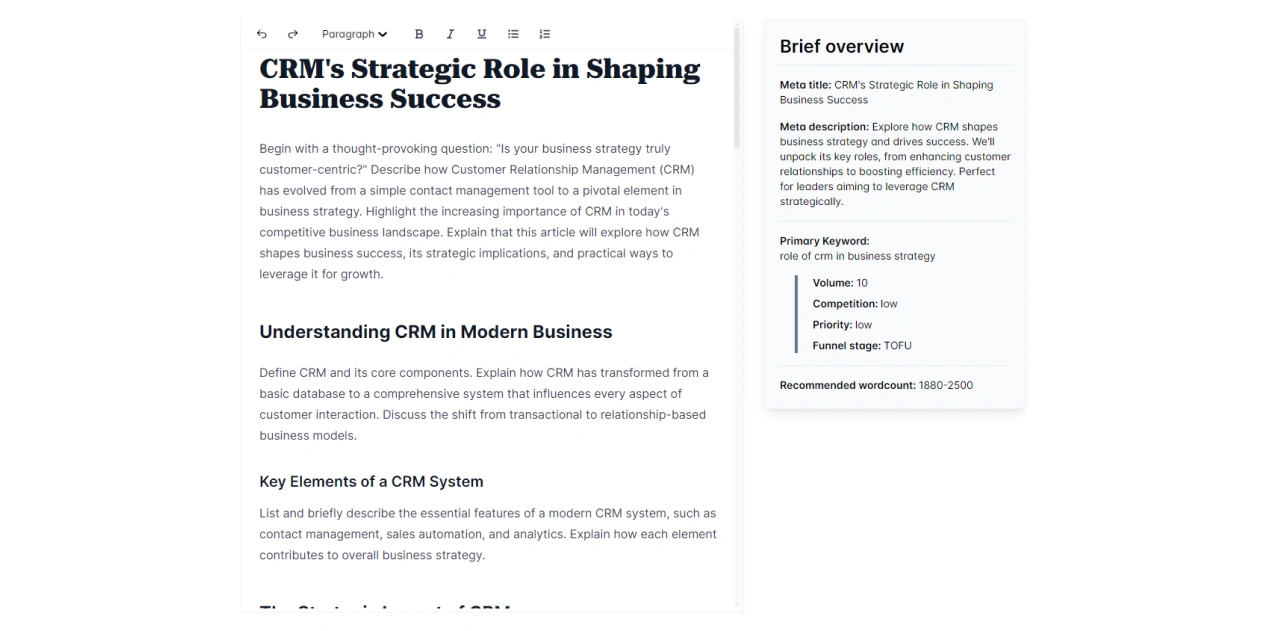
Does Your Content Approval Workflow Need a Revamp? Here Are 8 Signs

Co-Founder / CMO
Ever feel like your content approval process is a soul-crushing time suck? You're not alone.
For many content teams, the workflow for reviewing and approving pieces is a tangled mess of endless email threads, conflicting feedback, and missed deadlines. It's a productivity killer that leaves everyone frustrated and the quality of your content suffering. This is a common issue for many marketing teams.
An optimized content approval workflow isn't just a nice-to-have — it's mission-critical for any team that wants to operate efficiently and consistently put out great work. A smooth content approval process is essential.
When the content review process is smooth and streamlined, it frees you up to focus on what really matters: creating killer content that engages your audience. Content creators thrive in such an environment.
If any of those content workflow woes sound familiar, pay close attention. I'll outline 8 signs that your current process desperately needs an overhaul.
Use them as a wake-up call to finally bring order to the chaos and set your team up for content success.
Table of Contents
Let’s handle some misconceptions…
Too many teams resign themselves to thinking inefficient review processes are just the unavoidable cost of having multiple people provide feedback on content.
That's simply not true.
The root cause of most content approval headaches is a lack of structure and clear processes. Without those in place, every component of the workflow gets bogged down – gathering feedback, consolidating comments, implementing revisions, getting final sign-off, you name it. These are key steps in any content creation process.
It turns into a free-for-all.
Think of it like an assembly line.

If there's no defined process for how a product moves through each station and everyone's just winging it, that line will grind to a halt pretty quickly. But with a well-oiled workflow, content can flow smoothly through each review stage without bottlenecks or redundancies slowing things down. This type of workflow is crucial for efficiency.
The reality is, having multiple reviewers doesn't have to mean an endless back-and-forth of conflicting feedback and missed deadlines.
You just need to get the workflow running like a well-oiled machine from the start. Once you do, those review delays and inefficiencies can become a thing of the past. A structured approval process is achievable.
But why doesn’t my existing content approval process work?
Ah, I see you're still relying on those old-school content approval methods like endless email threads and shared drives. No wonder your workflow feels stuck in the stone age! This type of workflow is outdated.
Those manual processes were fine back when content demands were lower and teams were smaller.
The fundamental problem with those legacy methods is they lack structure, visibility, and accountability.
With email, feedback gets siloed and lost in the void. Shared drives are a nightmare when multiple people need to access and edit files simultaneously. It's the antithesis of a streamlined workflow.
Modern content teams require centralized, purpose-built content writing tools for managing the entire review and approval process from start to finish. One that provides a clear roadmap for how content moves through each stage, who's responsible for what, and an auditable trail of all activity.
Ditch those outdated tactics that rely on tribal knowledge and pray everything doesn't fall through the cracks. If you want an efficient, scalable content operation, it's time to level-up your workflow using the right tools for the job.
8 red flags your content approval workflow needs a revamp
Let’s look at some of the red flags your content approval workflow is in desperate need of an overhaul:
1. Feedback is scattered across multiple channels
When reviewers are providing feedback by email, Word docs, PDF comments, Slack, etc., it's inevitable that some will get lost or missed.
This fragmented approach means your authors waste tons of time digging through multiple channels to consolidate all the input. Not only is it a productivity drain, but missed feedback leads to incomplete revisions and lower-quality content.
The fix
Implement a centralized platform where all feedback lives in one place. Writers get a full-on view of all comments mapped to each section of the content. This leads to continuous improvement in the review cycle.
2. There's no centralized view of a piece's status

If you constantly find yourself asking "Where is this piece in the approval process?" you have a workflow problem. Without visibility into the current stage and status, it's impossible for writers and editors to know what's next.
This lack of clarity means the piece gets stuck in limbo as stakeholders are left wondering whose court the ball is in.
The fix
A purpose-built workflow solution that provides a centralized dashboard showing the real-time status of every piece of content. At a glance, you can see what stage it's in, who is working on it, what the next step is, and more. Identifying these key steps clearly is vital.
3. Revision rounds feel never-ending
Does it ever feel like no matter how many times you revise a piece of content, reviewers always seem to find one more thing to nitpick?
Those endless cycles of incremental changes are a huge time-suck and a workflow red flag. It likely stems from content editors providing feedback in a vacuum, without being able to see or build on each other's input.
The fix
A collaborative review process that allows stakeholders to provide feedback in a single environment, so they can see and resolve conflicting comments in real-time. No more blindly duplicating efforts. This fosters continuous improvement.
4. You constantly miss deadlines

Whether it's for campaigns, events, product launches, or whatever, there's nothing more stressful than scrambling to get content approved before a hard deadline. Missed deadlines mean missed opportunities and often require painful last-minute quality sacrifices. This impacts your content calendar.
The fix
Build deadlines and due dates into your workflow from the very start.
Identify all the key steps and stakeholders involved, then work backward from the final due date to set milestones for each stage of review.
Automated reminders keep things on track.
5. Giving feedback is a free-for-all
If reviewers are providing unstructured, stream-of-consciousness feedback in the body of an email or Word doc, get ready for conflicting input, redundant comments, and a nightmare of trying to decipher what applies to what.
The fix
Use a tool that allows reviewers to provide structured feedback directly mapped to specific sections of the content. They can easily reference what others have already commented on to avoid overlap.
6. Inconsistent review criteria
Does it ever feel like reviewers are nitpicking completely different things or applying their own personal preferences?
That's a sign you lack clear, consistent criteria for how content should be evaluated during reviews. This applies to every type of content, from a blog post to a whitepaper.
Everyone is just kind of winging it based on their own subjective standards.
The fix
Establish documented review guidelines that clarify exactly what reviewers should be assessing. Provide a framework around areas like brand voice, SEO, messaging, etc. so feedback is focused and objective. Content creators need this clarity.
7. Content briefs are an afterthought
Kicking off content creation without a clear, agreed-upon brief is a recipe for wasted efforts and misalignment.
If content editors are constantly pushing back because "this isn't what we discussed" or "this isn't hitting the goal" then your workflow is breaking down before it even starts. This will derail any type of content.
The fix
Implement a consistent briefing process using pre-defined templates. From the start, spell out the target audience, messaging objectives, topics to cover, keywords, etc., so everyone is marching towards the same desired outcome. This makes the content creation process much smoother for each content writer.
You can use a tool like Yahini tocreate advanced content briefs set on proven templates and guidelines from experienced content strategists. Yahini has gathered brilliant minds in content marketing to build your go-to tool for expert-level content strategy and briefs.
Yahini's briefs are built on over 50 pages of strategic frameworks created by veteran content pros.

Having that level of strategic rigor baked into your content briefs from the start provides crystal clear alignment for authors and reviewers.
No more ambiguity around goals, messaging, or target audience. Everyone works towards an agreed-upon North Star using consistent guidelines and templates.
8. No one knows who has the final say
In dysfunctional workflows, content is often pinged back and forth between stakeholders because there's no clear process for resolving conflicting feedback and determining the final sign-off. This creates endless cycles of revisions and frustrating bottlenecks. Even external stakeholders can get caught in this loop.
The fix
Establish a structured approval process that identifies the key steps, stakeholders involved at each stage (including key stakeholders), and most importantly, the single decision maker who has final say before the content can progress to the next step. This is crucial for an effective content approval process.
Does your content workflow feel like an uphill battle? Maybe it’s you, maybe it’s your brief…
If so, you're not alone - but that doesn't mean you have to resign yourself to the struggle. Maybe it's your process, maybe it's the lack of a solid strategic foundation from the start. Either way, ignoring those inefficiencies and pain points will only lead to continued headaches. This type of workflow needs continuous improvement.
I urge you to audit your current content approval workflow and identify the biggest bottlenecks and breakdowns.
Are feedback rounds an endless cycle? Do you constantly miss deadlines for your blog post? Is there confusion around roles and responsibilities for each content writer?
You need the right strategic foundation and processes in place first. That's where Yahini comes in.
It offers you the strategic advice you need to create a content strategy from the ground up. Its AI has been trained by seasoned content creators, providing you with expert-level content briefs right at your fingertips.
Ditch the generic outlines! Sign up now.